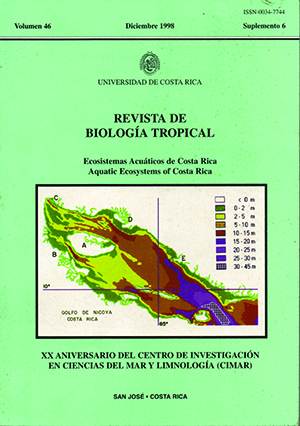Abstract
The Golfo de Nicoya is among the largest tropical estuaries (1530km2) in Central America and the main. and already overexploited. fishing area of Costa Rica. It can be separated into a shallow (25m) interior part fringed by mangroves and mud flats and a deeper part that extends to the shelf edge to about 200m. In order to integrate available information on biomass. catches. food spectrum and dynamics of the main species populations of the system. a trophic model of 21 compartments was constructed by the use of tile ECOPATH II software. The larger portion of system biomass is confined to the benthic domain (18.4 gm-2, mangroves excluded, compared to 13.8 gm-2 for the pelagic domain). Mangroves, although only covering 1% of tile gulf area, contribute 76% to the system biomass, but only about 1%, to the system's primary production. Through their root system, their provide surface area for about 90% of the gulfs biomass of epifauna (12 gm-2), the second largest group of the model. It serves as food source for commercially important species and also fuels the system by the production of large amounts of pelagic larvae and faecal material. Based on these findings, it is emphasized that mangroves, even if they cover only small areas of an estuarine system. have a fundamental role in biomass distribution and flow pattern. and must be considered when constructing a trophic model of the system. Most of !he system's energy throughput is achieved from the trophic levels I to II (62%) and II to III (34%) as expected for coastal phytoplankton/detritus based systems. Total catch amounts to 3.38 gm-2. which is considered intermediate for tropical coastal systems. A high gross efficiency of the fishery (catch/ primary production) of 0.3% confirms the known high level of fisheries exploitation in the Golfo de Nicoya As shown by the model, shrimps occupy a central role within the gulf as converters of detritus and other food into prey biomass for many predators, that seem to be simultaneously affected by the overexploitation of this resource. The network summary stadistics computed for the model suggest an overall picture of!he Golfo de Nicoya as a system of a low degree of maturity, which seems to be characteristic for tidally driven. tropical estuarine systems. The results are compared and discussed with other published trophic models of coastal systems. Among these, is Golfo Dulce, a further Costarrican gulf system about 200km south of the Golfo de Nicoya.##plugins.facebook.comentarios##

This work is licensed under a Creative Commons Attribution 4.0 International License.
Copyright (c) 1998 Revista de Biología Tropical
Downloads
Download data is not yet available.


